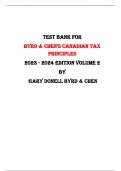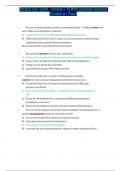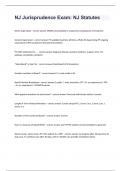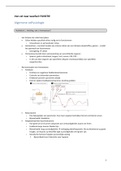-
1. Examen - Test bank for maternal & child health nursing care of the childbearing & childrearin...
-
2. Examen - Test bank for professional nursing: concepts & challenges 9th edition by beth black ...
-
3. Examen - Test bank for introduction to maternity and pediatric nursing 9th edition by gloria ...
-
4. Examen - Test bank for contemporary nursing issues, trends, & management 9th edition by barba...
-
5. Examen - Test bank for basic pharmacology for nurses 19th edition by michelle willihnganz, sa...
-
6. Examen - Test bank for gould's pathophysiology for the health professions 7th edition by karin...
-
7. Examen - Test bank for medical-surgical nursing: assessment and management of clinical problem...
-
8. Examen - Test bank for clinical manifestations and assessment of respiratory disease 8th edit...
-
9. Examen - Test bank for community and public health nursing 10th edition by cherie. rector, ma...
-
10. Examen - Test bank for fundamentals of nursing 9th edition by carol taylor, pamela lynn, jenn...
-
11. Examen - Test bank for dewits medical surgical nursing concepts and practice 4th edition by h...
-
12. Examen - Test bank for leading and managing in nursing 8th edition by patricia s. yoder-wise, ...
-
13. Examen - Test bank for porth’s pathophysiology concepts of altered health states 10th edit...
-
14. Examen - Test bank for porth’s essentials of pathophysiology 4th edition by tommie l.norris...
-
15. Examen - Test bank for nutritional foundations and clinical applications a nursing approach ...
-
16. Examen - Test bank for pharmacology and the nursing process 9th edition by linda lane lilley,...
-
17. Examen - Test bank for textbook of basic nursing 11th edition by caroline bunker rosdahl, mar...
-
18. Examen - Test bank for medical surgical nursing concepts for interprofessional collaborative ...
-
19. Examen - Test bank for varcarolis' foundations of psychiatric mental health nursing: a clinica...
-
20. Examen - Test bank for lehne's pharmacology for nursing care 11th edition by jacqueline burch...
-
21. Examen - Test bank for clinical nursing skills and techniques 10th edition by anne griffin pe...
-
22. Examen - Test bank for jarvis physical examination and health assessment 8th edition by caroly...
-
23. Examen - Test bank for psychiatric nursing contemporary practice 7th edition by mary ann boy...
-
24. Examen - Test bank for fundamentals of nursing active learning for collaborative practice 3rd ...
-
25. Examen - Test bank for seidel's guide to physical examination an interprofessional approach 1...
-
26. Examen - Test bank for williams’ basic nutrition and diet therapy 16th edition by staci nix ...
-
27. Examen - Test bank for bates’ guide to physical examination and history taking 13th edition ...
-
28. Examen - Test bank for maternal-child nursing 6th edition by emily slone mckinney, susan r. ja...
-
29. Examen - Test bank for community public health nursing 7th edition by mary a. nies, melanie m...
-
30. Examen - Test bank for burns' pediatric primary care 7th edition by dawn lee garzon maaks, na...
-
31. Examen - Test bank for essentials of psychiatric mental health nursing a communication approa...
-
32. Examen - Test bank for maternity and women's health care 12th edition by deitra leonard lowde...
-
33. Examen - Test bank for nursing delegation and management of patient care 2nd edition by kathle...
-
34. Examen - Test bank for concepts for nursing practice 3rd edition by jean foret giddens |all ch...
-
35. Examen - Test bank for philosophies and theories for advanced nursing practice 3rd edition by...
-
36. Examen - Test bank for basic geriatric nursing 7th edition by patricia a. williams |all chapt...
-
37. Examen - Test bank for growth and development across the lifespan 2nd edition by gloria lei...
-
38. Examen - Test bank for applied pathophysiology a conceptual approach to the mechanisms of di...
-
39. Examen - Test bank for principles of pediatric nursing caring for children 7th edition by ja...
-
40. Examen - Test bank for burns and grove's the practice of nursing research 9th edition by jenn...
-
41. Examen - Test bank for advanced physiology and pathophysiology essentials for clinical practic...
-
42. Examen - Test bank for beckmann and ling's obstetrics and gynecology 8th edition by robert ca...
-
43. Examen - Test bank for pharmacotherapeutics for advanced practice a practical approach 5th edi...
-
44. Examen - Test bank for success in practical vocational nursing from student to leader 9th edit...
-
45. Examen - Test bank for fundamentals of nursing care concepts, connections & skills 3rd edition...
-
46. Examen - Test bank for medical-surgical nursing 7th edition by adrianne linton, mary ann matt...
-
47. Examen - Test bank for pharmacotherapeutics for advanced practice nurse prescribers 5th editi...
-
48. Examen - Test bank for principles of anatomy and physiology 16th edition by gerald tortora, b...
-
49. Examen - Test bank for understanding pathophysiology 7th edition by sue e. huether, kathryn l...
-
50. Examen - Test bank for abrams’ clinical drug therapy rationales for nursing practice 12th ...
-
51. Examen - Test bank for pharmacology clear and simple a guide to drug classifications and dosa...
-
52. Examen - Test bank for essentials of pediatric nursing 4th edition by theresa kyle, susan carm...
-
53. Examen - Test bank for gerontological nursing 10th edition by charlotte eliopoulos |all chapte...
-
54. Examen - Test bank for foundations for population health in community public health nursing 5t...
-
55. Examen - Test bank for health assessment for nursing practice 7th edition by susan fickertt wi...
-
56. Examen - Test bank for hamric & hanson's advanced practice nursing an integrative approach 7t...
-
57. Examen - Test bank for fundamentals of nursing 10th edition by potter perry |all chapters, y...
-
58. Examen - Test bank for focus on nursing pharmacology 8th edition by rebecca tucker, amy m. ka...
-
59. Examen - Test bank for wong's nursing care of infants and children 11th edition by marilyn j. ...
-
60. Examen - Test bank for leadership roles and management functions in nursing theory and applica...
-
61. Examen - Test bank for maternal-newborn nursing: the critical components of nursing care 3rd ...
-
62. Examen - Test bank for lehne's pharmacotherapeutics for advanced practice nurses and physician...
-
63. Examen - Test bank for foundations of maternal-newborn and women's health nursing 7th edition ...
-
64. Examen - Test bank for basic nursing thinking doing and caring 2nd edition by leslie s. trea...
-
65. Examen - Test bank for primary care: art and science of advanced practice nursing - an interpr...
-
66. Examen - Test bank for pathophysiology the biologic basis for disease in adults and children ...
-
67. Examen - Test bank for psychiatric-mental health nursing 8th edition by shelia videbeck |all ...
-
68. Examen - Test bank for maternity and pediatric nursing 3rd edition by susan scott ricci, susan...
-
69. Examen - Test bank for introductory maternity and pediatric nursing 4th edition by nancy t. h...
-
70. Examen - Test bank for medical-surgical nursing concepts for interprofessional collaborative ...
-
71. Examen - Test bank for applied pathophysiology for the advanced practice nurse 1st edition b...
-
72. Examen - Test bank for fundamentals of nursing 11th edition by patricia a. potter, anne griff...
-
73. Examen - Test bank for a concise introduction to logic 13th edition by patrick j. hurley, lori...
-
74. Examen - Test bank for advanced practice nursing: essentials for role development 4th edition ...
-
75. Examen - Test bank for maternity and pediatric nursing 4th edition by susan scott ricci, susan...
-
76. Examen - Test bank for microbiology: an introduction 13th edition by gerard tortora , berdell...
-
77. Examen - Test bank for psychiatric mental health nursing: concepts of care in evidence-based p...
-
78. Examen - Test bank for roach’s introductory clinical pharmacology 11th edition by susan m. f...
-
79. Examen - Test bank for understanding nursing research building an evidence-based practice 7th ...
-
80. Examen - Test bank for essentials for nursing practice 9th edition by patricia a. potter, anne...
-
81. Examen - Test bank for the human body in health and disease 8th edition by kevin t. patton, fr...
-
82. Examen - Test bank for mccance & huether’s pathophysiology the biologic basis for disease in...
-
83. Examen - Test bank for understanding medical surgical nursing 6th edition by linda s. william...
-
84. Examen - Test bank for pediatric nursing the critical components of nursing care 2nd edition...
-
85. Examen - Test bank for essentials of psychiatric mental health nursing 8th edition by karyn i...
-
86. Examen - Test bank for essentials of maternity newborn and women's health nursing 5th edition ...
-
87. Examen - Test bank for fundamental concepts and skills for nursing 6th edition by patricia a. ...
-
88. Examen - Wiley series 63 exam review test bank + study guide uniform securities agent state la...
-
89. Examen - Test bank for pathophysiology the biological basis for disease in adults and children...
-
90. Examen - Test bank for pediatric nursing critical components of nursing care 3rd edition by ka...
-
91. Examen - Test bank for mckinney evolve resources for maternal-child nursing 5th edition mckinn...
-
92. Examen - Test bank for byrd & chen's canadian tax principles volume 2 2022 - 2024 edition by g...
-
93. Examen - Test bank for byrd & chen's canadian tax principles volume 1 2022 - 2024 edition by g...
-
94. Examen - Test bank for health assessment in nursing 7th edition by janet r weber and jane h ke...
-
95. Examen - Test bank for health assessment in nursing 7th edition by janet r weber and jane h ke...
-
96. Examen - Test bank for essentials of nursing leadership and management 7th edition by sally a....
-
97. Examen - Test bank for understanding abnormal behavior 11th edition by david sue, derald wing ...
-
98. Examen - Test bank for health promotion throughout the life span 9th edition by carole edelm...
-
99. Examen - Test bank for advanced practice nursing: essential knowledge for the profession 3rd ...
-
100. Examen - Test bank for health promotion throughout the life span 10th edition by carole lium...
-
101. Examen - Test bank for health promotion throughout the life span 8th edition by carole lium ...
-
102. Examen - Test bank for gerontologic nursing 5th edition by sue e. meiner |all chapters, year...
-
103. Examen - Test bank for introduction to critical care nursing 7th edition by mary lou sole, de...
-
104. Examen - Test bank for psychotherapy for the advanced practice psychiatric nurse a how-to guid...
-
105. Examen - Test bank for understanding anatomy & physiology : a visual, auditory, interactive a...
-
106. Examen - Test bank for anatomy and physiology openstax |all chapters, year-2024|
-
107. Examen - Test bank for microeconomics 14th edition by michael parkin |all chapters, year-2024...
-
108. Examen - Test bank for marketing 4th canadian edition lamb, hair, mcdaniel, faria, wellington ...
-
109. Examen - Test bank for prehospital emergency care 12th edition by joseph j. mistovich, keith ...
-
110. Examen - Test bank for human anatomy & physiology 8th edition by jerri k. lindsey, elaine n. ...
-
111. Examen - Test bank for campbell biology 11th edition by lisa a. urry, michael l. cain, steven ...
-
112. Examen - Test bank for animal physiology 4th edition by richard w. hill, gordon a. wyse, marga...
-
113. Examen - Test bank for study guide to accompany computers and data processing by harvey m. de...
-
114. Examen - Test bank for the economics of money, banking, and financial markets 9th edition by ...
-
115. Examen - Test bank for human resources management in canada 15th canadian edition by gary dess...
-
116. Examen - Test bank for introducing psychology 4th edition by daniel schacter , daniel gilbert...
-
117. Examen - Test bank for ragan - macroeconomics 16th canadian edition by christopher t.s. ragan...
-
118. Examen - Test bank for ragan - economics 14th canadian edition by christopher t.s. ragan |all ...
-
119. Examen - Test bank for recruitment and selection in canada 7th edition by catano, hackett, wie...
-
120. Examen - Test bank for practical law of architecture, engineering, and geoscience 3rd canadia...
-
121. Examen - Test bank for database systems design, implementation, & management 14th edition by c...
-
122. Examen - Test bank for wong's essentials of pediatric nursing 11th edition by marilyn j. hocke...
-
123. Examen - Solution manual for intermediate accounting, 18th edition, by donald e. kieso, jerry ...
-
124. Examen - Test bank for catalano nursing now: today's issues, tomorrows trends 8th edition by j...
-
125. Examen - Test bank for lehne’s pharmacotherapeutics for advanced practice nurses and physici...
-
126. Examen - Test bank for keltner’s psychiatric nursing, 9th edition by debbie steele |all chap...
-
127. Examen - Test bank for psychiatric nursing 8th edition by norman l. keltner |all chapters, ye...
-
128. Examen - Test bank for primary care interprofessional collaborative practice 6th edition by te...
-
129. Examen - Solution manual for intermediate accounting, 7th edition by david spiceland, mark nel...
-
130. Examen - Test bank for leadership and nursing care management, 7th edition by diane huber, m. ...
-
131. Examen - Test bank for pathophysiology 7th edition by jacquelyn banasik chapter |all chapters,...
-
132. Examen - Securities industry essentials exam study guide 2024 + test bank |all chapters, year...
-
133. Examen - Test bank for human anatomy 6th edition by marieb, wilhelm, mallatt |all chapters, y...
-
134. Examen - Test bank for applied statistics ii multivariable and multivariate techniques 3rd ed...
-
135. Examen - Test bank for a concise introduction to logic 11th edition by patrick j. hurley |all...
-
136. Examen - Test bank for safe maternity & pediatric nursing care second edition by luanne linna...
-
137. Examen - Test bank for nursing care of older adults: diagnoses, outcomes, and interventions by...
-
138. Examen - test bank for pharmacology a patient-centered nursing process approach 10th edition ...
-
139. Examen - Test bank for hamric and hanson's advanced practice nursing an integrative approach 6...
-
140. Examen - Test bank for neeb's mental health nursing 5th edition by linda m. gorman, robynn anw...
-
141. Examen - Test bank for seidel's guide to physical examination an interprofessional approach 9t...
-
142. Examen - Test bank for critical care nursing diagnosis and management 9th edition by linda d. ...
-
143. Examen - Test bank for nursing today: transition and trends 10th edition by joann zerwekh and ...
-
144. Examen - Test bank for davis advantage for pathophysiology introductory concepts and clinical ...
-
145. Examen - Test bank for bontragers textbook of radiographic positioning and related anatomy 10t...
-
146. Examen - Test bank for foundations of financial management 17th edition by stanley b. block, g...
-
147. Examen - Test bank for foundations and adult health nursing 9th edition by kim cooper and kell...
-
148. Examen - Test bank for the language of medicine 11th edition by davi ellen chabner |all chapte...
-
149. Examen - Test bank for community and public health nursing 3rd edition by rosanna demarco and ...
-
150. Examen - Test bank for psychiatric mental health nursing: concepts of care in evidence-based p...
-
151. Examen - Test bank for foundations of nursing 9th edition by kim cooper & kelly gosnell |all c...
-
152. Examen - Test bank for introductory clinical pharmacology 12th edition by susan m ford |all ch...
-
153. Examen - Test bank for brown and mulholland’s drug calculations: ratio and proportion proble...
-
154. Examen - Test bank for canadian fundamentals of nursing 6th edition by patricia a. potter, ann...
-
155. Examen - Test bank for canadian fundamentals of nursing 6th edition by patricia a. potter, ann...
-
156. Examen - Test bank for basic nursing-thinking, doing, and caring, 3rd edition by leslie s. tre...
-
157. Examen - Test bank for calculate with confidence 7th edition by deborah gray morris |all chapt...
-
158. Examen - Test bank for pathophysiology a practical approach 4th edition by lachel story |all c...
-
159. Examen - Test bank for primary care the art and science of advanced practice nursing – an in...
-
160. Examen - Test bank for foundations of mental health care 8th edition by morrison-valfre |all ...
-
161. Examen - Test bank for lewis's medical-surgical nursing in canada: assessment and management o...
-
162. Examen - Test bank for medical-surgical nursing concepts & practice 5th edition by stromberg |...
-
163. Examen - Test bank for pharmacology for canadian health care practice 3rd edition by linda lil...
-
164. Examen - Test bank for public health nursing: population-centered health care in the community...
-
165. Examen - Test bank for introductory medical-surgical nursing 10th edition by barbara k timby, ...
-
166. Examen - Test bank for nursing leadership, management, and professional practice for the lpn/l...
-
167. Examen - Test bank for oral pathology for the dental hygienist 7th edition by olga a c ibsen a...
-
168. Examen - Test bank for dental radiography principles and techniques, 5th edition by joen iannu...
-
169. Examen - Test bank for phillips's manual of i.v. therapeutics: evidence-based practice for inf...
-
170. Examen - Test bank for the human body in health and illness 6th edition by herlihy |all chapte...
-
171. Examen - Test bank for leadership roles and management functions in nursing theory and applica...
-
172. Examen - Test bank for heizer operations management 9th edition by jay heizer, barry render |a...
-
173. Examen - Test bank for lehninger principles of biochemistry 7th edition by david l. nelson, mi...
-
174. Examen - Test bank for focus on adult health medical surgical nursing 2nd edition by linda hon...
-
175. Examen - Test bank for current medical diagnosis and treatment by maxine papadakis, stephen mc...
-
176. Examen - Test bank for maternal child nursing care: optimizing outcomes for mothers, children ...
-
177. Examen - Test bank for microbiology: a systems approach, 6th edition by marjorie kelly cowan, ...
-
178. Examen - Test bank for nursing for wellness in older adults 8th edition by carol a. miller |al...
-
179. Examen - Test bank for maternity and pediatric nursing 4th edition by susan scott ricci, susan...
-
180. Examen - Test bank for hdev : human lifespan development 6th edition by spencer a. rathus |all...
-
181. Examen - Test bank for operations and supply chain management 13th edition by f. robert jacobs...
-
182. Examen - Test bank for financial accounting for mbas 8th edition by easton, wild, halsey, mca...
-
183. Examen - Test bank for electrocardiography for healthcare professionals 5th edition by kathryn...
-
184. Examen - Solution manual for statistics for nursing research a workbook for evidence-based pra...
-
185. Examen - Test bank for radiation protection in medical radiography 9th edition by mary alice s...
-
186. Examen - Test bank for urinalysis and body fluids 7th edition by susan king strasinger, marjor...
-
187. Examen - Test bank for davis advantage for fundamentals of nursing theory concepts and applica...
-
Montrer plus








